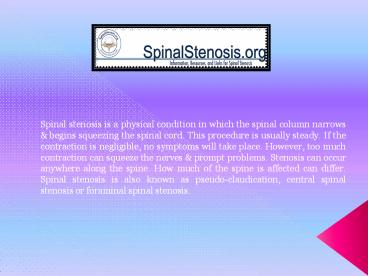Spinal stenosis Symptoms - PowerPoint PPT Presentation
Title:
Spinal stenosis Symptoms
Description:
A lot of people with spinal stenosis lead full lives & remain active. However, they may require to make changes to their physical activity. Many people experience residual pain after treatment or surgery. – PowerPoint PPT presentation
Number of Views:36
Learn more at:
http://stenosisspinal.org/spinal-stenosis-symptom
Title: Spinal stenosis Symptoms
1
Spinal stenosis is a physical condition in which
the spinal column narrows begins squeezing the
spinal cord. This procedure is usually steady. If
the contraction is negligible, no symptoms will
take place. However, too much contraction can
squeeze the nerves prompt problems. Stenosis
can occur anywhere along the spine. How much of
the spine is affected can differ. Spinal stenosis
is also known as pseudo-claudication, central
spinal stenosis or foraminal spinal stenosis.
2
Spinal stenosis causes
Aging is probably the most typical cause of
spinal stenosis. Degenerative processes take
place all through your body as it ages. Tissues
in your spine may commence to coagulate, and
bones may get bigger, squeezing the nerves.
Conditions such as rheumatoid arthritis and
osteoarthritis may also contribute to spinal
stenosis. The swelling they source can put strain
on your spinal cord.
3
Spinal Stenosis Treatment
Pharmaceutical treatment is usually tried first.
The objective is to ease out your pain. Cortisone
injections into your spinal column can decrease
swelling. Nonsteroidal anti-inflammatory drugs
(NSAIDs) can also help with pain. Physical
therapy may also be a choice. It can strengthen
muscles gently stretch your body.
4
Surgery may be required for severe pain or if
theres a neurological loss. It can ease out
pressure permanently. Several kinds of surgery
are employed to treat spinal stenosis such as
Laminectomy, Foraminotomy, and Spinal fusion.
5
Contact us
1818 N Vermont Ave Los Angeles, CA, United
States PH-(551) 774 4330 http//stenosisspinal.or
g/

